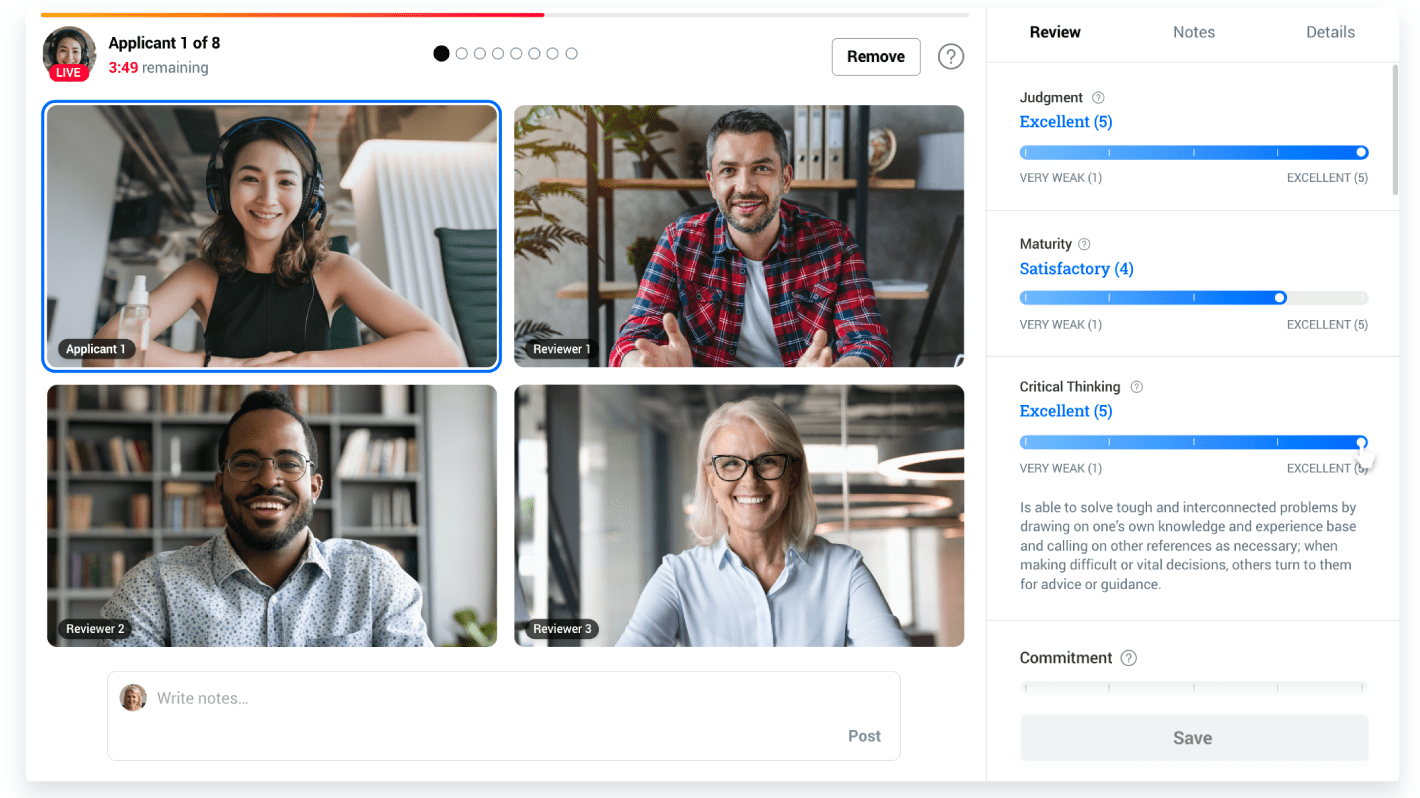The funnel helps you visualize how a student moves from considering your program to actually applying for it, how you can reach them at each stage of the funnel and move them through it, and how effectively you’re marketing your program.
Gaining a clear understanding of this is vital if you want to attract students, engage them, and eventually “convert them” into applicants. And here’s the good news: it’s not as complicated as you think.
The Four Stages of the Funnel
There are many different ways to design a marketing funnel, but we’re going to stick to the tried and true model of: attract, engage, convert, and close.

Each of these stages has its own set of goals, success metrics, and key activities you can perform. Your mission, should you choose to accept it, is to move students through each stage of the funnel using those activities until they’re ready to apply to your program.
So let’s get started.
Attract—Top of Funnel
This is the beginning of the student journey. At this early stage in the funnel, students are really just beginning to explore their options. They aren’t sure which school they want to apply to, and may not even be sure if they want to get their degree at all.
They may have had limited exposure to your school in the past, but they’re far from deciding whether or not to apply to your program.
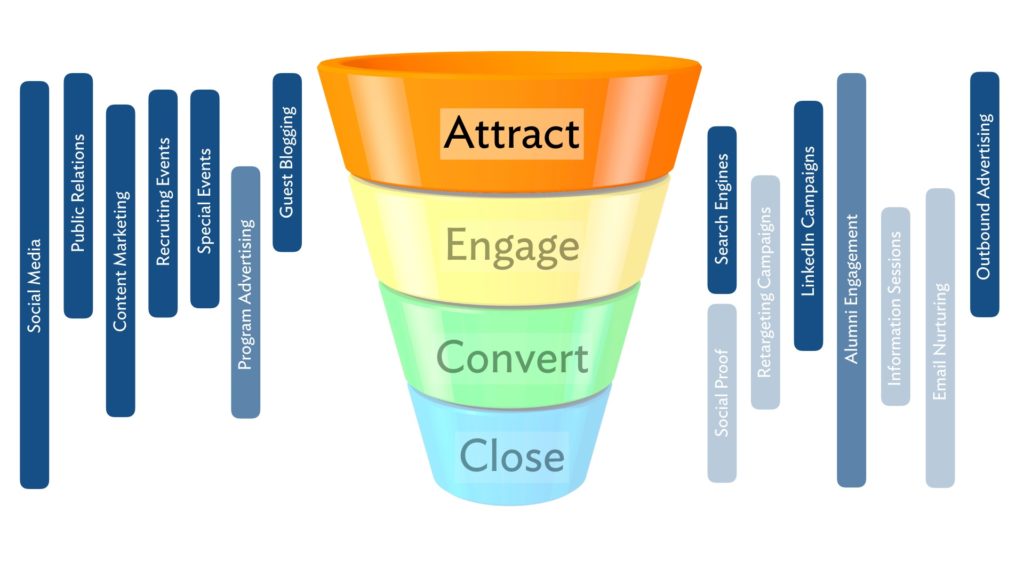
It’s critical to understand that at this stage in the funnel the vast majority of students will NOT be ready to apply to your program. It’s far too early for them to make a decision like that, and asking them to do so will be ineffective, or worse, may turn them away from your school entirely.
Think about it: if you walked into a car dealership and the first thing the salesperson did was put a sales contract in front of you, how would you feel?
So if you’re not asking them to apply for your program at this stage, what should you be doing instead?
You want to attract them. You want to inspire them. You want to entertain them.
And most importantly, you want to drive them to your website, social media channels, or anywhere else you can, including conferences or events that you sponsor.
Marketing mix: While you should always feel comfortable talking about your program, you should strive for a 75/25 balance—75% engaging content, 25% program specific campaigns.
Here’s a great example from Northwestern Law's Facebook page. In this case, they’re leveraging a recent controversial news topic, creating content about it, and sharing it with the hopes of driving you to their website. This kind of campaign (called newsjacking in PR) is sure to generate clicks to their website from anybody who is interested in the topic they’re discussing. It’s simple, effective, and most importantly—authentic.
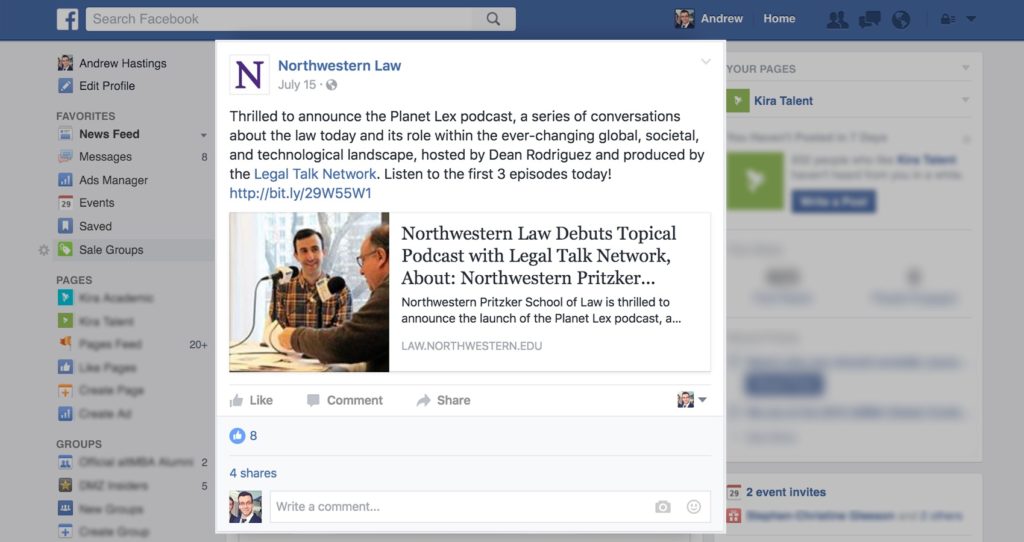
Goals for This Stage of the Funnel
Your goals for this very early stage in the funnel should focus on building awareness instead of trying to generate leads.
- Attract students to your website, social media channels, or events.
- Inspire students with a picture of how their life will look after getting their degree.
- Inform students with your take on a current event.
- Entertain students with interesting content that drives them to your website.
Success Metrics
How will you know it’s working? By keeping an eye on these success metrics.
- Website Traffic (Unique visitors, Total visits)
- Social Engagement (Likes, Follows, Subscribes, Retweets)
- Multimedia Playback (Views, Shares, and Comments on your videos)
- Media Mentions (Frequency and Quality of press coverage)
- Email Metrics (Open rate, Click rate, Response rate)
- Campaign Performance (Impressions, Clicks)
Key Marketing Activities
There are a lot of different things you can do to raise awareness of your school or program, these are just a few. Resist the temptation to launch everything and instead select ones that your team can execute on effectively. Less is more. Focus on quality instead of quantity.
Write Great Content
Great content can require a significant amount of resources to produce, but the results can be astounding. Great content will drive people to your website, will be shared on social media, and can produce a substantial amount of press coverage. Lucky for you, faculty and students spend a large amount of time doing research and producing content already. How can you leverage that?
Attend Events
Attending industry-specific recruiting events, such as conferences, or career-centred events for new or soon-to-be graduates from undergraduate programs, are both great ways to meet students who are serious about their path but haven’t quite narrowed down their top school choices.
Host Events
Like a great piece of content, a special event hosted or sponsored by your school is a great way to attract a wide variety of potential applicants. These will focus less on recruitment and more on the inform and entertain side of things.
Be Social
Social media is an essential component to all successful top of funnel strategies. This is where you’ll share your content and target potential applicants with it.
Strategize With PR
Public Relations is the original social media. Sure, you can’t target specific groups of people as easily, but the potential for building brand awareness and buzz about your school is unmatched.
What publications are your applicants reading? What kind of interesting content can you share with those publications so that they syndicate it? What newsworthy breakthroughs have your faculty or alumni made that are worth media coverage?
Introduce Guest Bloggers
Writing great content for your school is great, but what if you could get access to a much larger audience? Well, you can. What blogs are your applicants reading? Think about that. Next, approach those blogs and offer up some syndicated, or completely exclusive content for them to post on their website.
Leverage Your Alumni Community
Your alumni community should be your strongest group of advocates, and their research, achievements, and success stories should be at the forefront of your marketing campaigns and content.
Master Search Engine Marketing
Whether you’re paying for ads on Google or not, search engine optimization is an essential activity if you want your school to have a favorable ranking on local searches such as “[faculty] programs in [state]”, or “top programs for [subject area] or [career outcome]”.
Outbound Marketing Campaigns
Outbound campaigns deserve a special place on this list—dead last. Not because they’re ineffective, but because it’s too easy for a school to spend money on advertising while ignoring the fundamentals of effective marketing. Whether you’re choosing to advertise on social media, industry websites, or email, don’t neglect the fundamentals outlined earlier.
Engage—Middle of Funnel
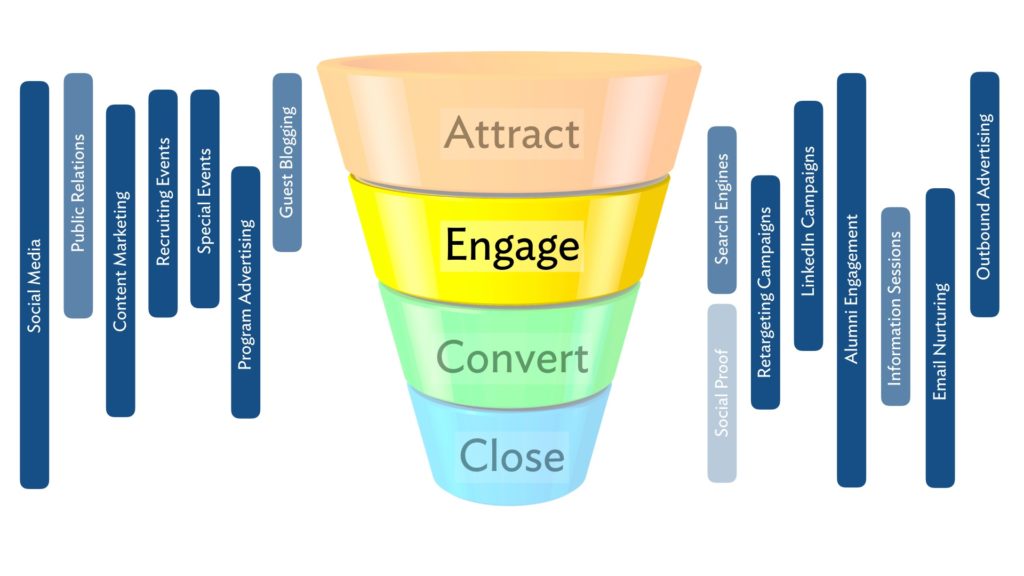
Welcome to the middle of the funnel, where students have now been to your website, read one of your blog posts, attended one of your events, or followed you on social media (or any combination of those).
Prospective students are now aware of your school, your program, and may be doing research on how your school may be able to fulfill their wants and needs. They’re also researching your competitors. Students are looking at their options, and the school that engages with them on their level, adds value to the relationship, and does the best job communicating their value proposition has the best chance of winning them over.
Keep in mind that you probably don’t know who your visitors are yet. They haven’t told you. All you can see at this stage is that somebody visited your website or clicked on one of your campaigns. They’re still a number, not a name. It’s time to change that.
If you haven’t already done so, this is the perfect time to think back to those philosophical questions you answered earlier. What makes your program different than your competitors? Why should this student care? Every marketing channel they engage you on should tell that story.
Marketing mix: You should feel comfortable advertising your program to them at this point, but a good approach is a 60/40 distribution—60% great content, 40% program specific campaigns.
This is also a great time to take advantage of a relatively new advancement in online advertising: retargeting campaigns. Retargeting software, like AdRoll, allows you to show advertising campaigns to anybody who has visited your website in the past.
It’s easy, affordable, and extremely effective. In fact, if you can get students to visit your website just a single time, you can continue to show them campaigns for a fraction of the price when compared to other forms of advertising.

Here’s a screenshot of a retargeting campaign for Queen’s MBA program appearing on Inc. shortly after I visited their website. Now that I’ve visited the Queen’s MBA website, the program can continue to advertise to me wherever I go for a fraction of the price. Smart.
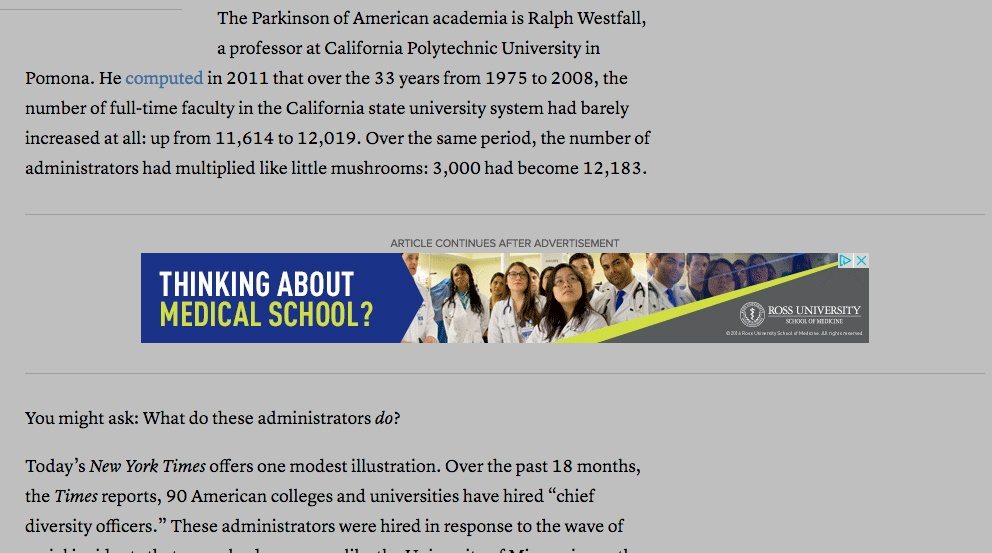
Here is another example from Ross University School of Medicine. I've been searching for medical schools, so they are advertising their online assessment tool that provides feedback on my application chances:
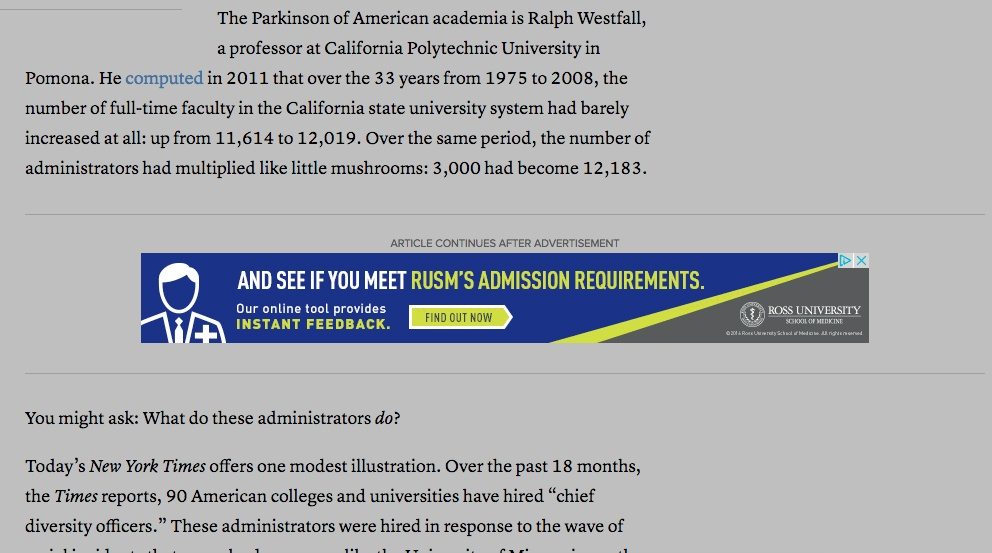
Goals for This Stage of the Funnel
Your goals for this stage of the funnel center around relationship building and driving continued engagement with your school. You want to turn them from a number into a name in your database.
Add Depth to the Relationship
This can take many forms, but in general it means communicating with them frequently, adding value to the relationship by sharing interesting content, inviting them to special events, and making sure you’re open to two-way dialogue if they contact you.
Get Their Contact Information
Getting prospective applicants to your website for the first time is the most expensive part, so don’t let them leave without getting their contact information—even if it’s just an email address. This can be achieved in various ways, such as a newsletter subscription, a social media follow, an event registration, or by requiring an email address to access specific pieces of content you develop.
Attract, Inspire, Entertain...and Inform
Keep them coming back for your great content, but inform them with the occasional message about your program.
Focus on Micro-Engagements
Encourage them to engage with you as often as possible. They should be seeing your ads everywhere, receiving emails from you, seeing your tweets on social media, your campaigns on LinkedIn, reading your content, and seeing you at events. Every touchpoint counts.
Success Metrics
- New Contacts Created (Number of email addresses collected, blog subscriptions, newsletter signups, forms filled out)
- Website Traffic (Unique visitors, Total visits)
- Social Engagement (Likes, Follows, Subscribes, Retweets)
- Multimedia Playback (Views, Shares, and Comments on your videos)
- Media Mentions (Frequency and Quality of press coverage)
- Email Metrics (Open rate, Click rate, Response rate)
- Campaign Performance (Impressions, Clicks)
Key Activities
Virtually all of the activities that we mentioned at the top of the funnel still apply, but there are a few nuanced differences in the middle of the funnel.
Retargeting Campaigns
Use retargeting campaigns to show applicants advertising campaigns for your program, your content, or anything else you want to share as they visit other websites. This is essential for staying top of mind and can actually save you substantial amounts of money in the long run.
Write Great Content
You want them to keep coming back for your content, so continue writing great content for your website and keep an eye out for guest blogging opportunities.
Email Nurturing Campaigns
By now you may have their email address or social media information, so start sending highly targeted, relevant campaigns based on the content that you produce, along with a few well-timed program-specific campaigns to pique their interest in your program.
Conferences and Recruiting Events
Whether you’re attending a large recruiting event or you’re hosting your own, these have value at every stage in the funnel because meeting students face to face is still one of the best ways to engage them and build that relationship.
Convert—Bottom of Funnel
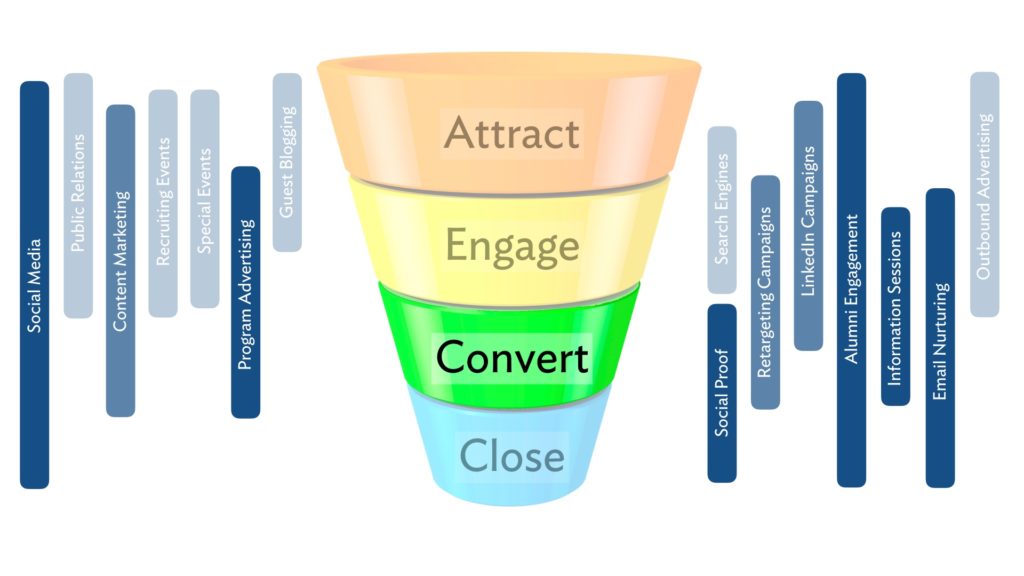 This is the stage where all of your hard work comes to fruition. At this stage in the funnel students are well informed. They understand the market, your offering, and hopefully what makes your program different from your competitors.
This is the stage where all of your hard work comes to fruition. At this stage in the funnel students are well informed. They understand the market, your offering, and hopefully what makes your program different from your competitors.
They’ve been to your website, read your content, subscribed to your newsletter, followed you on social media, met with your team at an event, or any combination of those things (and more).
At this stage you should prioritize educating them about your program. Don’t be afraid to talk about your school, the benefits of of getting their degree, what makes you different, and why they should apply or reach out for more information.
Marketing mix: At this stage you can prioritize information about your program over sharing content—a good approach is a 25/75 distribution—25% great content, 75% program specific campaigns.
Most importantly, make sure you offer them multiple ways to express their interest. Not every student is ready to apply at this stage, so offering a series of intermediary steps is a good approach.
Here’s an example of what Yale School of Management does to encourage students to take the first step to becoming an applicant.
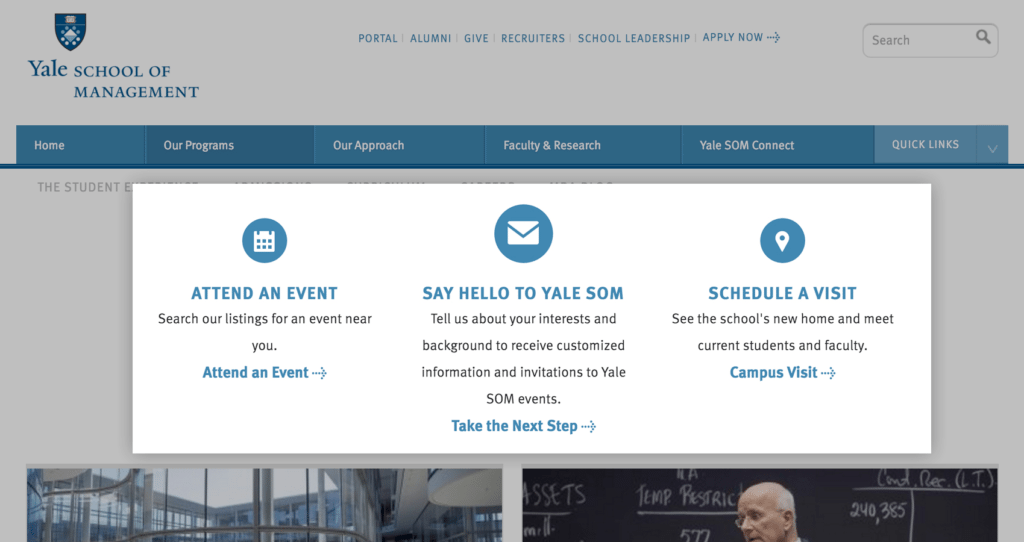
Rotman School of Management at the University of Toronto takes this a step further by offering students nine different ways to “explore, connect, and apply”. This may actually be too many options, but if properly tested it may prove to be an effective strategy.
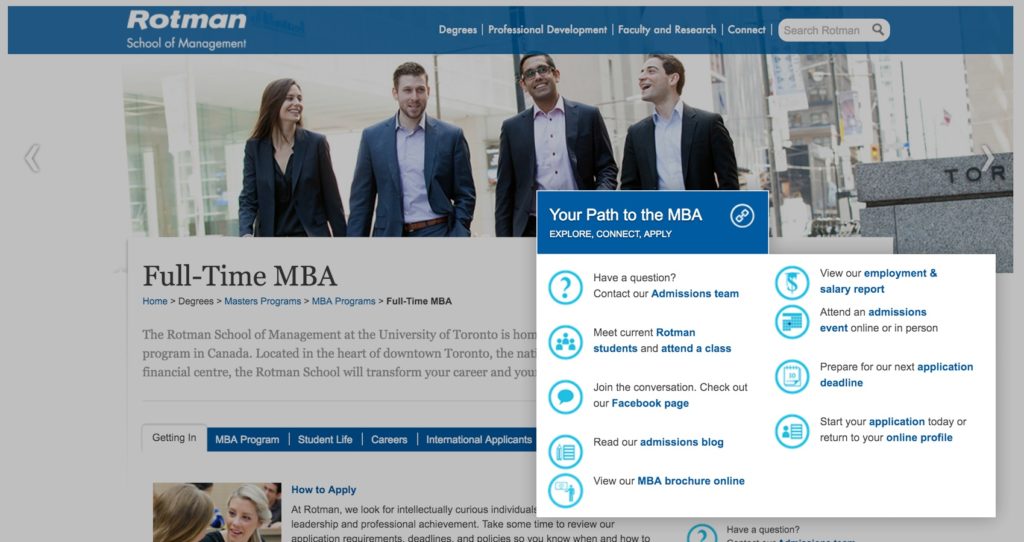
Goals for This Stage of the Funnel
Your goals here will vary depending on how many different ways you allow students to express their interest and apply for your program, but here are a few common ones:
- Have them fill out a form and contact you for more information.
- Schedule a campus visit.
- Attend an admissions event.
- Schedule a meeting with you at a conference.
- Convert them into an applicant.
Success Metrics
- New Applications Received
- Information Requests
- Campus Visits Scheduled
- Recruitment-oriented Event Attendees
- Website Traffic (Specifically traffic to your program specific pages)
- Email Metrics (Specifically opens, clicks, and responses to your program specific campaigns)
- Campaign Performance (Specifically views and clicks on your program specific advertising campaigns)
Key Marketing Activities
The same key activities in the other stages of the funnel still apply, but there are a few new ones to consider:
Website and Landing Page Optimization
It’s important to make sure that your website is being continually tested and optimized to ensure that you’re capturing as many leads as possible. If your marketing team can’t tell you the “conversion rate” of your school’s website, something is wrong. You could be losing applicants as a result.
Program-Specific Campaigns
Don’t be afraid to talk about your program at this stage in the funnel. Take full advantage of retargeting, email marketing, LinkedIn, and other campaign platforms to drive students to apply for your program.
Program-Specific Content
At this stage, your content strategy should prioritize the creation and distribution of content related to your program and the value that it can deliver. This can include brochures, ROI calculators, case studies, and even marketing videos.
Information Sessions
Offer up information sessions in as many formats as you can—including both online in the form of webinars, or in-person on your campus.
Social Proof
Featuring successful alumni, awards your program has won, or if you’re really lucky, favorable rankings in publications like US News, are great ways to push students who are on the fence past the finish line.
The Final Stages—Close and Evangelize
Close (yield)
This stage of the funnel is so important that deserves its own lesson, which is why we’re going to cover the topic of improving yield in Week Four of this program. We’ve got tons of great information to help you ensure you’re enrolling as many applicants as possible.
Evangelize (alumni engagement)
This isn’t really part of the funnel, but it’s worth a quick mention. Once a student graduates from your school it’s important to continue to engage them as alumni. This activity pays dividends right at the top of your funnel for student recruitment.
We spoke with Bruce DelMonico, Assistant Dean, Admissions, at Yale School of Management about how Yale’s managed to vastly increase their yield rate over the last two years. Yale has worked to integrate students and grads into their admissions process to give applicants a truly honest review of the school.
“Use students, alumni, and faculty as ambassadors. This is something every school likely already does, but thinking about ways to leverage the entire school community and forge connections between it and potential students at appropriate times and in appropriate ways can make a difference,” he recommends.
“As much as candidates want to speak with us, they want to speak with students and alumni that much more, so making those connections has real value.”
This isn’t the end…
In fact, this is just the beginning of your journey towards marketing your program more effectively and attracting more students in the process. It’s time to build your own funnel. My recommendation: start from the top down.
Your biggest priority should be attracting more potential students to your website with great content and smart campaigns, so call a meeting with your marketing team and get started today!
Thanksgiving. That glorious day where you get together with friends and family, eat whatever you want, and most importantly, enjoy an extra long weekend. This time to relax is important, especially if you work in admissions -- arguably one of the most interesting, frustrating, and unique careers out there.
This year we asked admissions teams across the country what they were thankful for and we got a lot of great responses. Read on to hear about them. Oh, and don’t forget to leave what you’re thankful for in the comments below!

(more…)
Plagiarism. Falsified documents. Black market consultants. It sounds like the plot of a Hollywood movie, but it's not -- it's just a day in the life of an admissions team at universities and colleges around the world.
Admissions fraud is a problem facing virtually every admissions team at a competitive school, whether they realize it or not. At Kira, we've been working hard to bring this issue to light. In fact, our eBook, titled 'Admissions Fraud: The Truth Behind the Application', has been read by hundreds of admissions teams in North America and was even featured in USA Today.
But we want to do more than just talk about the problem. We want to help you prevent it at your school, since according to our informal survey, 71 percent of schools do not have a process in place to prevent and detect fraudulent applications.
(more…)
I have a confession to make: I plagiarized my MBA admissions essay.
Well, not really. But I did go undercover and hire a black market admissions consultant to write a typical Ivy League business school admissions essay for me.
This is my story.
Exposing Admissions Fraud
I was reading through various topics that students were discussing on graduate school admissions message boards late one evening.
One particular section caught my eye—it was dedicated exclusively to people with questions about the written application components that many schools require. I wasn’t surprised to see it since it’s the most challenging part of the application for many students.
As I scrolled through the seemingly endless number of posts where students would ask others for feedback on their essays, I kept seeing mentions of “consulting services” that would “give you professional feedback” for a price. “Interesting,” I thought. “But do any of these consulting services take it a step further?” (more…)

